
Original Link: https://www.anandtech.com/show/2920
Enermax Gold: Modu87+ and Pro87+
by Christoph Katzer on January 19, 2010 1:00 PM EST- Posted in
- Cases/Cooling/PSUs
We ring in the New Year with the introduction of some great new power supplies courtesy of Enermax. Enermax has always had a wide selection products ranging from mid- to high-end PSUs in a variety of wattages. Enermax is mostly active in the retail market so they've always had a good idea about how to design products that appeal to end-users. They have maintained a stable business in the retail market, especially in Germany. It comes as little surprise that Enermax was one of the fastest companies to introduce high efficiency power supplies to the market, with a lot of new features. That trend continues with their new 87+ series.

A little while ago Enermax introduced the Modu82+ and Pro82+ and we tested a total of four units. We thought it would be nice to continue with this trend and introduce all of the Modu87+ and Pro87+ series power supplies Enermax released this month. There is one feature on these new power supplies that helps them stand out in a crowded market: they are 80 Plus Gold certified. This alone doesn't make them unique as we already have many other 80 Plus Gold power supplies, but the Modu87+ and Pro87+ series both come with a starting wattage of 500W, making them far more interesting for a large number of end-users. Realistically, few systems really need a power supply that can output more than 500W, and getting a very high efficiency at common power draws is a bonus. Fortunately efficiency isn't the only noteworthy feature on these power supplies, but high efficiencies can only be reached with certain technologies. These technologies alone will make an overall better product out of a higher ranking 80 Plus certified power supply.
Both series are now available in three versions: of 500W, 600W, and 700W. There will be two more models rated at 800W and 900W in Q2 of this year. The good news is that the units we are introducing today have already been shipped and the first units should be on US shelves now or in the near future (we were unable to find any online as we publish this article). Enermax told us that there should also be some mail-in rebates and other incentives available to make these new power supplies even more attractive.
Package Contents and Specifications

As with the former Pro82+, the Pro87+ again omits cable management. This means that all of the cables are attached to the power supplies and you will not be able to remove any of them. In the package you will find a power cord, cable straps, a sticker, screws, the CordGuard™ and the manual in many different languages. The packages come with tons of explanations and information to show you why this power supply is better than the competition. It's a little too much if you ask us, but at least you have something to read once you spot one of these packages on the shelves of your local dealer.

The Modu87+ is the cable management version and comes with detached cables and a nice pouch to store unused cables. Additionally you get a power cord, screws, the CordGuard, a sticker, cable straps, and a manual.
Specifications
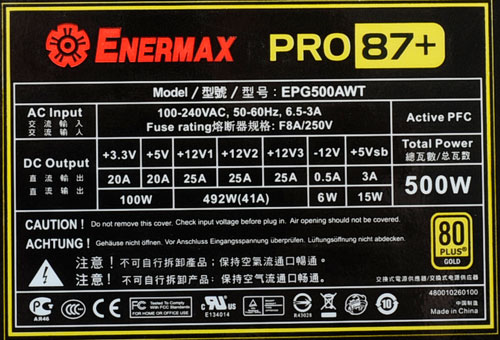
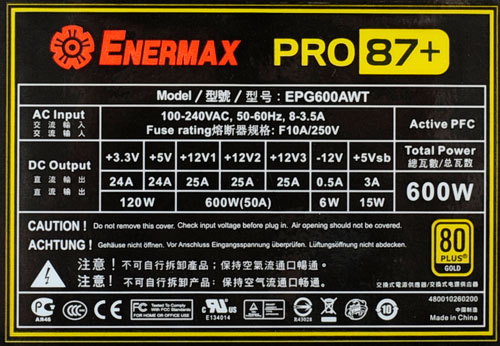
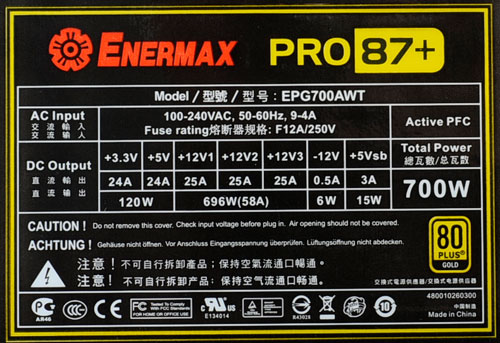
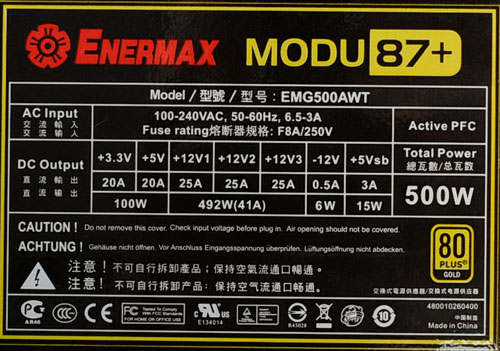
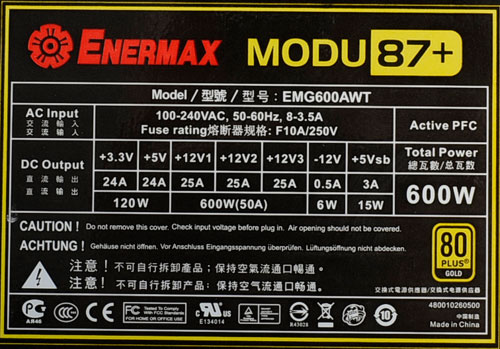
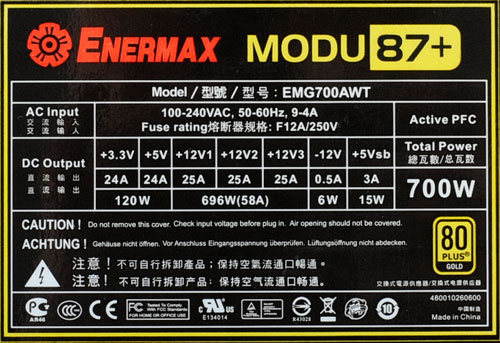
The internal structure is the same in both series; you will find the exact same PCB and components in a 500W Modu87+ as in a Pro87+. All of the different wattages come with the same three 12V rails of 25A; the difference is in the total combined power. Don't assume you can pull the same amount out of the different models, because there are other limitations that make this impossible. Specifically, some of the capacitors are smaller on the lower wattage models. Also worth note is that with only 20A to 24A on the 3.3V and 5V rails, Enermax follows the trend of modern systems that need less from these rails than older systems.
External Appearance

The new series from Enermax surprised us as we had imagine something completely different (thinking back to Computex from last year). At that time both series were equipped with a 12mm Magma fan and had a very rough sandblasted paint scheme. Enermax has returned to a more traditional look and we think the change was only for the better. In an effort to reduce costs Enermax had to keep painting to a minimum which is why these units now only come with simple black paint. On the other hand, not all the changes were an effort to reduce costs; an expensive feature for example is the 139mm shiny golden fan. It fits quite well with the design aesthetic actually and makes this new design look better than the previous one with the red Magma fan. There is one little detail that doesn't quite fit, however: the Enermax logo in the middle of the fan guard looks a little odd with the square shape over a circular fan. As always, beauty is in the eye of the beholder.
The Modu87+ power supplies have the cable management jacks at the front of the unit. There are five jacks with five pins and two with twelve. The jacks have the same size and shape as on other Enermax power supplies, and since the company offers separate cables in retail packages you can use old cables even if you want to switch to a new Enermax unit. Above the usual main switch and AC input you will find a small area with a note saying "Please put ENERMAX log sticker here." You can find the Enermax sticker in the package, but why bother? Enermax explained the reason for not attaching it in the factory is that the company doesn't know what direction the user is going to mount the power supply, since various cases have the PSU at the bottom and others have it at the top. If they pre-apply the sticker, it would be upside-down for some users. If you want your system to be "just so" after assembly, this might be an important consideration.
The CordGuard
Below the AC inlet and main switch you will find something new. These two hooks belong to the newly acquired patent from Zippy and now offered by Enermax called CordGuard.

The CordGuard is nothing more than a small wire-hook attached to the power supply. Once you connect the power cord you can lift the hook up to securely fasten the cable. This makes sense in households where you have the PC standing in an open space and someone could accidently pull out the cable. It might not be a critical feature for everyone, but it will undoubtedly come in handy for some users. Enermax will be modifying all of their PSUs to include the CordGuard function going forward, but we really don't think this is necessary.
Enermax posted this video on YouTube to show real life experiences and how they could be solved with CordGuard. We think it's dangerous to let kids play behind a PC in the first place, and let's just hope they don't notice the power switch….
Pro87+ Cables and Connectors

The cable lengths from the Pro87+ slightly differ from those on the Modu87+. We found for example shorter cables with PEG connectors. All cables are sleeved. The 500W unit has two 6+2-pin PEG connectors while both higher rated units come with four 6+2-pin PEG connectors. The length of these important cables is average ranging from 45cm (PEG) to 60cm (4+4-pin ATX12V). The main 24-pin connector has a length of 55cm. The 600W and 700W units have two different lengths for the PEG connectors, with two each of 45cm and 50cm. There are six to eight SATA connectors on these units, which is more than adequate for most setups. There are five Molex connectors on all of the units, which is also more than enough for the average user today.
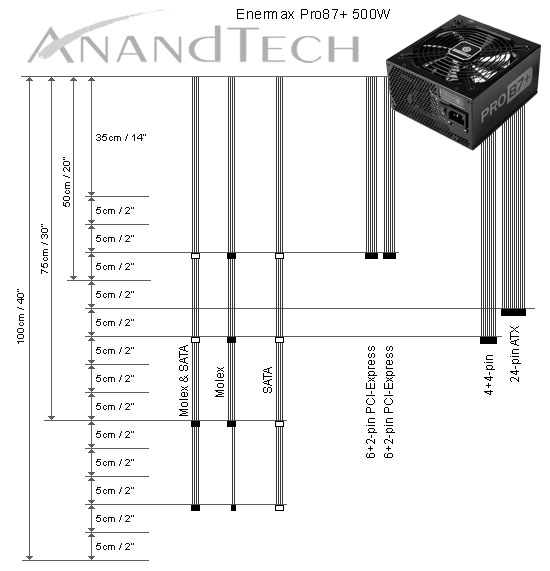
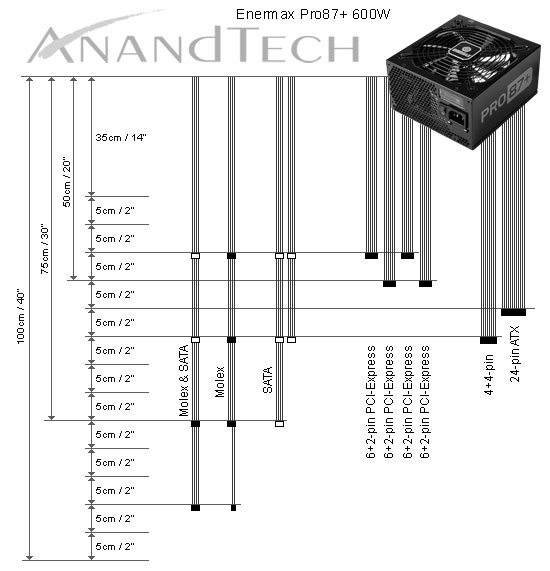
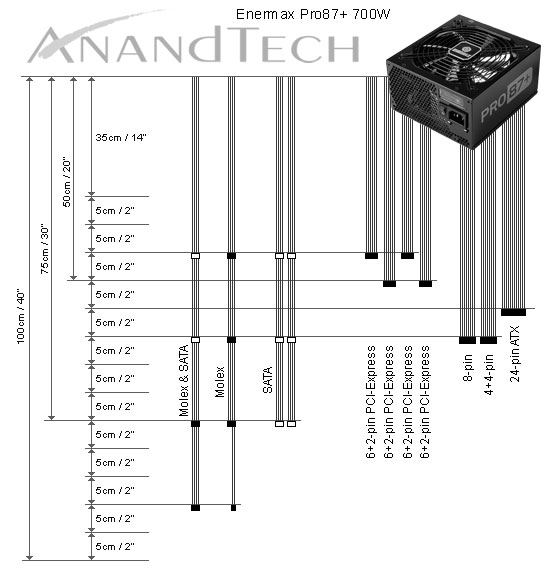
Modu87+ Cable and Connectors

The Modu87+ comes with the 24-pin main connector and the 4+4-pin ATX12V connector (and 8-pin for the 700W version) attached to the power supply. All other cables are detachable. The cables are also nicely sleeved. There are five jacks for peripheral cables and two for the PEG cables on each of the units. You can also buy a second PEG cable at your local store and have four PEG connectors on your 500W unit should you so desire, though you'll want to be careful about overloading the PSU with high-wattage GPUs in that case. The cables are slightly longer on the Modu87+ series. For instance, the PCI-E connectors are 5cm longer compared to the Pro87+ series. This series also differs from wattage to wattage in terms of the default connectors available.
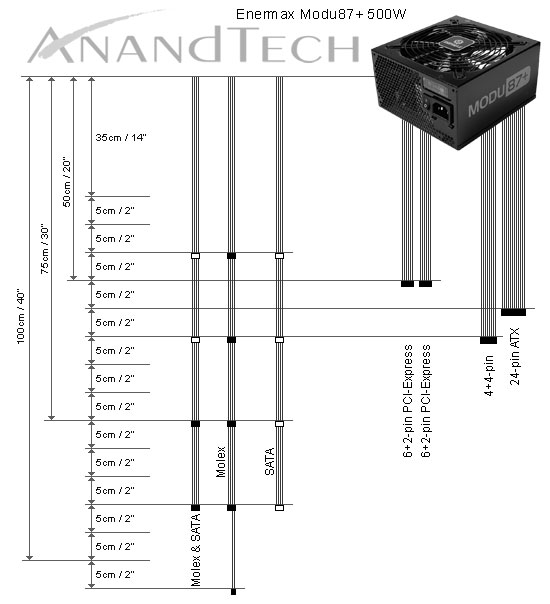
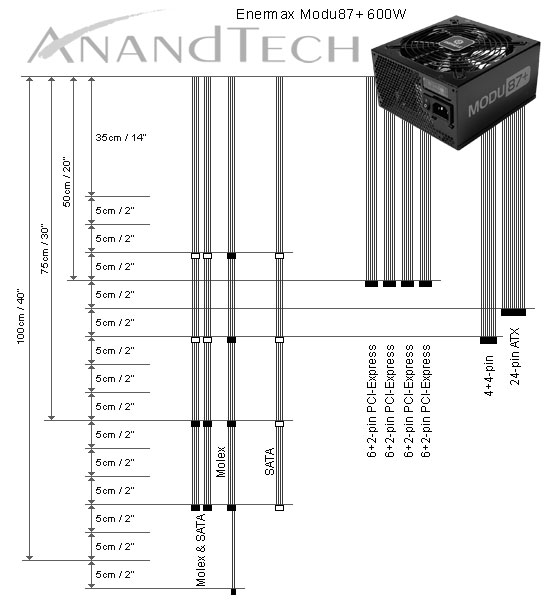
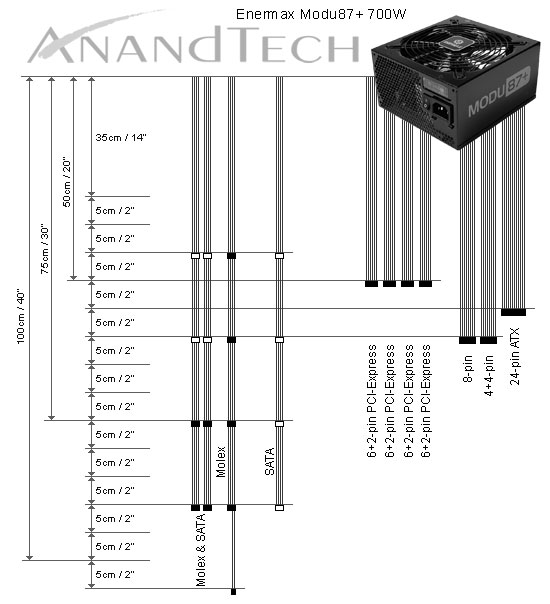
A look Inside

When opening this unit we couldn't really see anything different inside than you'd see in other power supplies. If you take a closer look you will find a few differences though. In fact this unit uses some of the same technology as Seasonic does in their latest X-series. Enermax's so called Dynamic Hybrid Transformer technology, part of the "resonant topology", is nothing more than a kind of gearbox for the components. This way Enermax can regulate the voltage that goes into the capacitor ranging from roughly 330V to 400V. If the load on the DC output is low the voltage to the capacitor will be lower as well, resulting in better efficiency. The same goes for the frequencies which will be decreased with higher loads and increased when the DC load is lower.
In the secondary part we see two "DC to DC" sister PCBs where the 5V and 3.3V rails are created. Below these two sister PCBs we find capacitors attached to another PCB vertically. Enermax actually carries a patent for this arrangement which is space saving and enhances the cooling of the attached components. Oh and don't mention the blue heatsinks. They do look strange inside a black and golden schemed power supply, but as you can remember back at Computex the housing was still dark matte black with a red fan installed. It made sense at the time and Enermax unfortunately had already produced all of the heatsinks and were unable to change those when the new look was introduced. For component geeks, there is a Rubycon capacitor in the primary and a lot of Nippon Chemi-Con caps in the secondary. The solid-state caps are made in Taiwan, though.
The overall quality is as we would expect from Enermax, but they still managed to top former achievements. As they previously worked with PCBs made of synthetic resin bonded paper (FR-2), things always looked a little shabby inside. With the new multi-layer PCB it all looks much cleaner and adds a huge percentage of quality to the units.
The Fan

Since Enermax bought its own fan company a while ago they started producing a wide range of funky fans. Together with their twister bearing they have come up with some pretty good fans lately and are in fact able to diversify the product ranges according to their actual needs. In the case of the Modu87+ and Pro87+ for example Enermax wanted a larger fan; 140mm is the largest possible in an ATX power supply today and it's already patented, so Enermax decided to make a 139mm fan themselves. Together with golden blades this fan looks truly amazing, and we are happy that there aren't any LEDs. The fan carries the model number EA142512W-OAB. Enermax also worked on the Hall-IC inside the fan and made it possible to run the fan at incredibly low RPMs, which we will see later.
Modu/Pro87+ 500W Voltage Stability and Quality
We tested all of the units we had on hand, but after comparing the results it was clear that similar models with the same wattage perform absolutely the same. We saw differences of only a tenth of a volt, which leads us to the conclusion that we only need to show only chart for each wattage and avoid the redundancy of showing both the Modu87+ and the Pro87+. The results of the Modu87+ and Pro87+ are virtually identical. In fact, Modu87+ performs a little better in our tests, despite the rumors that cable management adds additional resistance to the cables. There is additional resistance, yes, but it's so marginal that one can hardly see a real difference in a test lab. The difference at a user's home wouldn't be at all measureable, and the minor variation we tested between the Modu87+ and the Pro87+ is likely due to small variations between any two PSUs off the same production line.
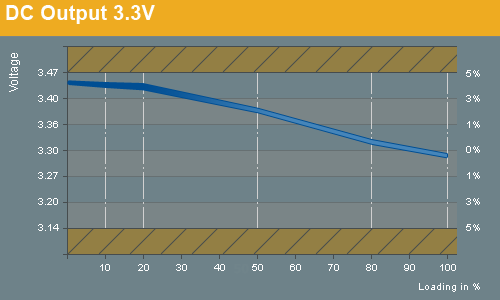
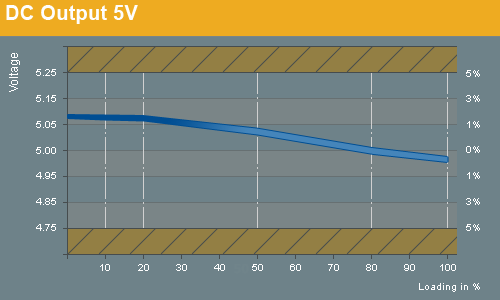
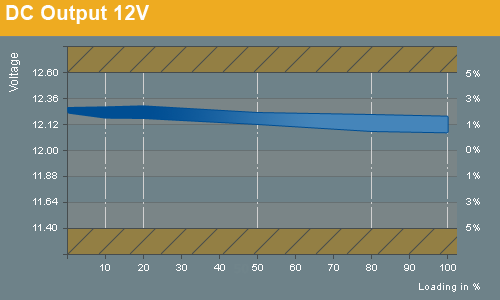
The voltage regulation for the 12V rail is fantastic. Both lower voltage rails are a little behind but still make a good impression. There is almost no fluctuation in the 12V rail and it provides stable output without breaking a sweat.
Ripple
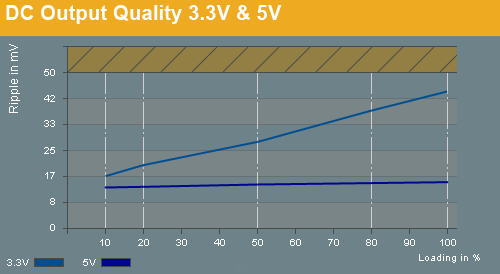
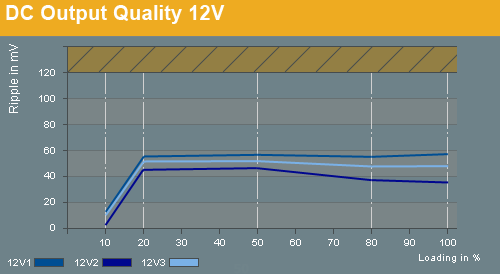
The 5V rail held stable with ripple of only 14mV, but the 3.3V rail ripple is sky-high - close to the maximum allowable amount according to the ATX specification. 3.3V output isn't critical these days, so we can overlook this "flaw". All three 12V rail are stable at 40mV to 60mV, which is by far the most important result.
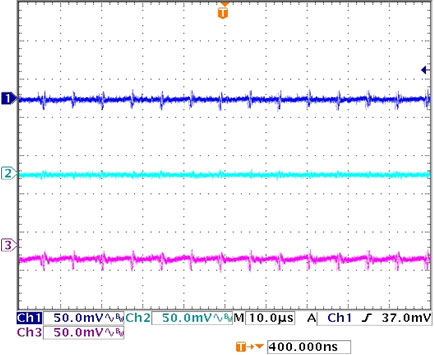
20% load
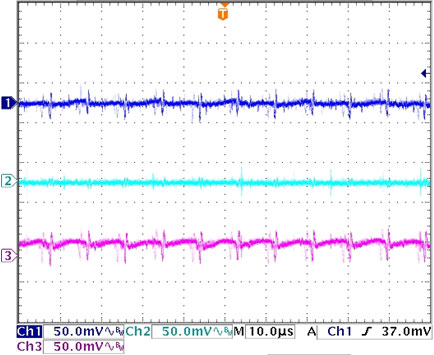
50% load
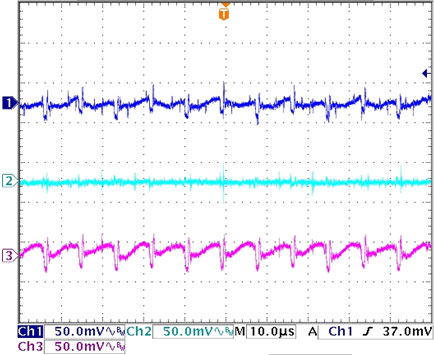
100% load
Modu/Pro87+ 600W Voltage Stability and Quality
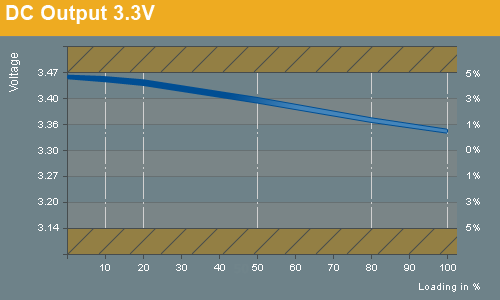
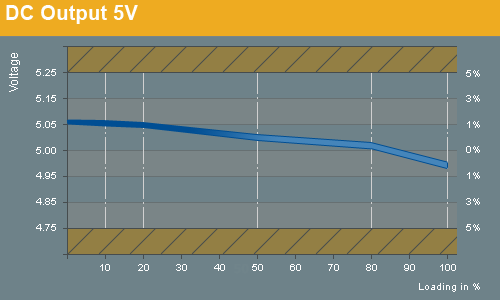
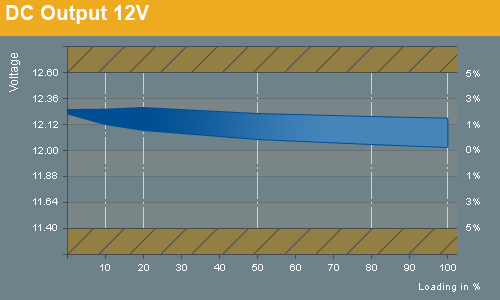
The 600W unit has a little better result compared to the 500W unit but we still see 4% fluctuation on the 3.3V rail. The 5V rail seems a little better with this unit with a regulation range of around 2%. The 12V rail has a slightly different regulation ranging from 12.34V down to 11.99V.That is of course still within specification.
Ripple
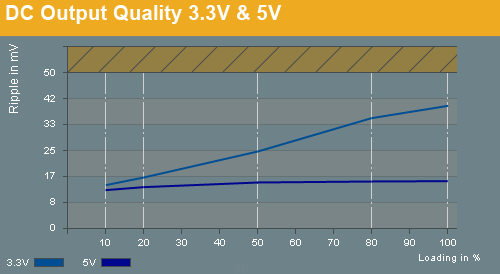
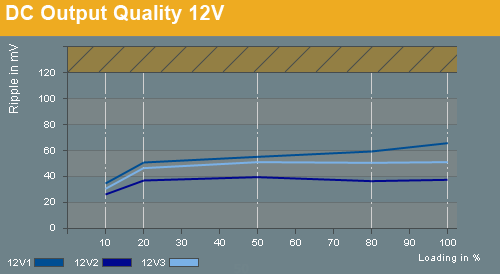
The ripple looks similar to the 500W unit with the 3.3V rail going up to around 40mV and the 5V rail being able to keep a stable 14-15mV. The 12V rail looks good with only up to 63mV on the 12V1 rail.
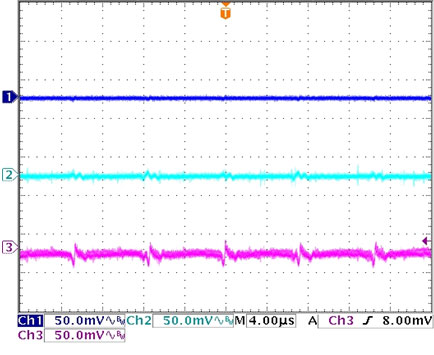
20% load
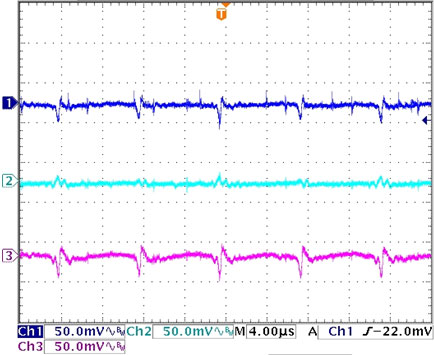
50% load
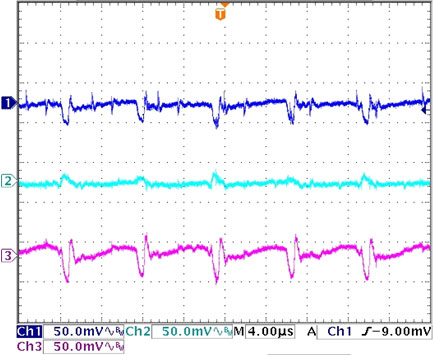
100% load
Modu/Pro87+ 700W Voltage Stability and Quality



Both of the smaller 3.3V and 5V rails drag themselves through half of our graphic and show a drop of around 3%. That still doesn't matter too much since they started at a high overvoltage of 3.41V and 5.14V respectively. The 12V rail again performs great with only 1% drop and very tight regulation. It's good to see this since most modern high-end components need these 12V rails.
Ripple
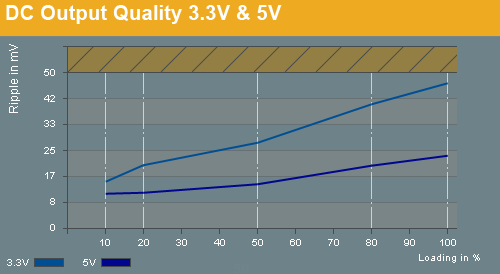
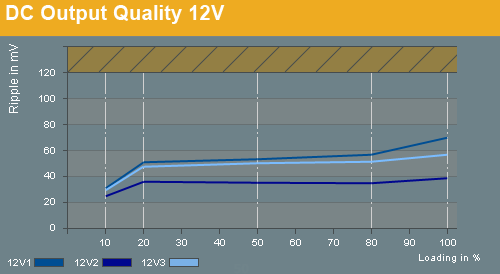
The higher ripple results on the 3.3V rail continue with the 700W unit as well, unfortunately, but it remains (barely) within spec. The 12V rails stay on an acceptable level of up to 70mV. Below you can see our noise charts for 20%, 50%, and 100% load on the 12V rails.
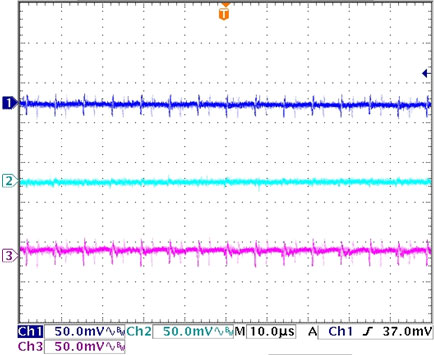
20% load
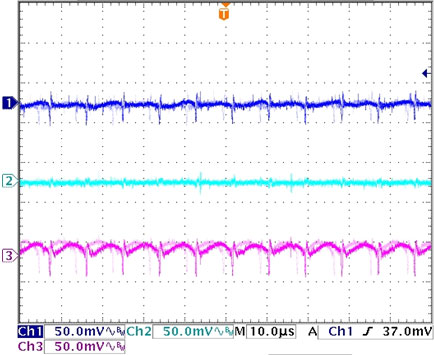
50% load
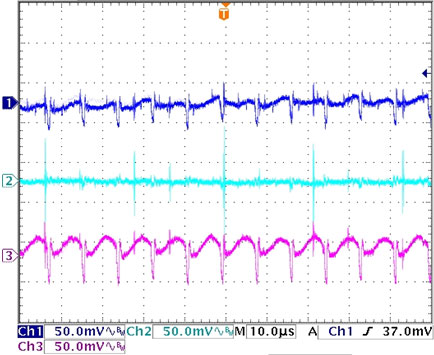
100% load
Temperatures, Fan Speed, and Acoustic Noise
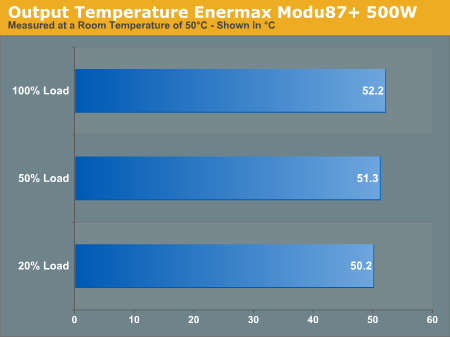
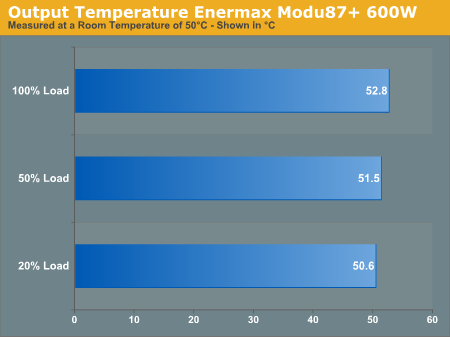
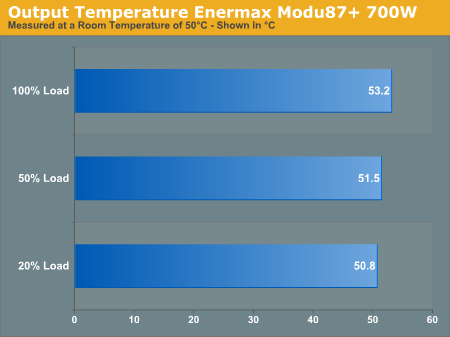
We have tested these units in a chamber with a constant temperature of 50°C to see if they are up to the challenge and don't blow up on us. Well, what can we say? The graphs above show the output temperature measured 1cm in front of the rear vent on each power supply. The measured temperature is just a few degrees over the input temperature. This means that the components inside produce very little heat that actually needs to be dissipated. This is related to the high efficiency these units are able to achieve, as we will see on the next page.
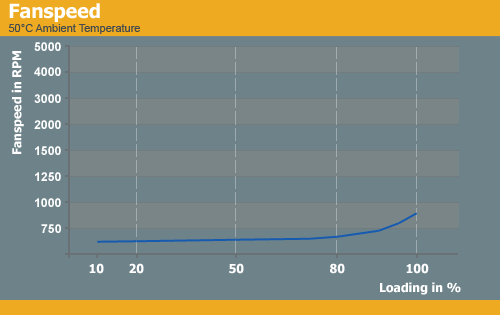
When you switch on these units and the fan starts turning you can actually almost see each blade while it turns. Enermax came up with a very good fan motor design and IC. The company is therefore able to lower the fan speeds to incredible 330 RPM, which is normally only possible with a PWM fan control. Enermax cannot use that approach (without paying royalties) since Antec has a patent on PWM fan controllers inside power supplies.
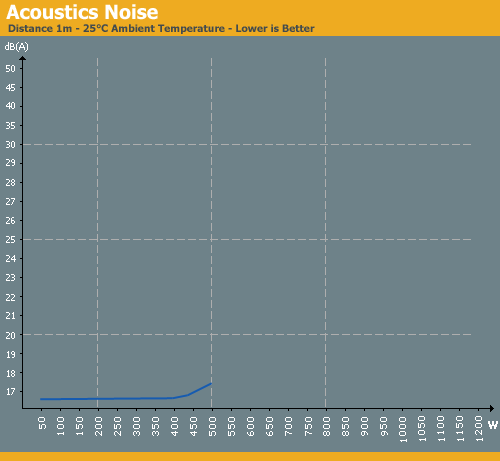
The low fan RPM continues through most loads, and even when we loaded the power supplies to their limits and left them running for longer periods of time we were not able to clearly hear the fans. When you put your ear close to a unit you will be able to hear a very light hum under full load but that's about it. Under lower loads you will never hear the fan and this makes these units unbeatable compared to the current competition of fan-cooled power supplies. Since all three units have the same curve we only included the 500W unit on the above graphic.
Efficiency and PFC
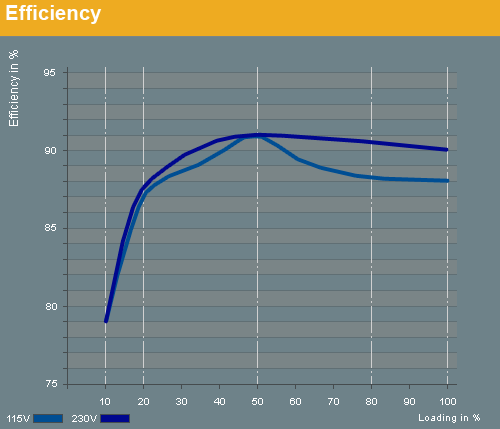
500W Efficiency
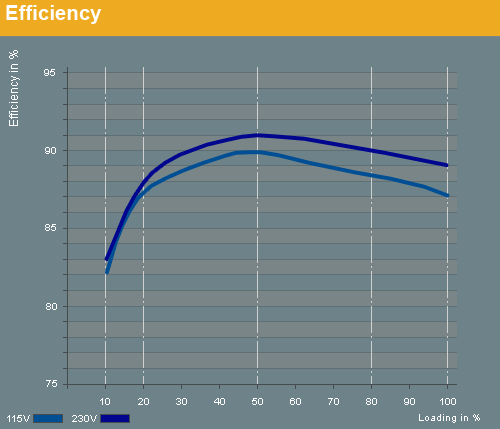
600W Efficiency
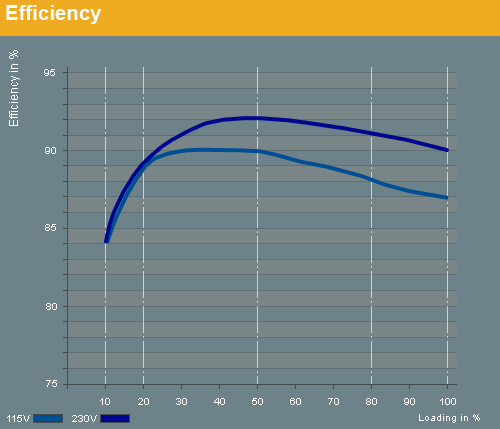
700W Efficiency
The efficiency is very good on these units, as we would expect from any PSU with an 80 Plus Gold certification. Even though they do much better with 230VAC, buyers in the U.S. market will also be able to enjoy efficiencies of up to 90%. The 500W unit is the only one able to reach 91% on 115VAC at around 250W load. Users with 230VAC will be able to enjoy premium efficiency, with the 700W models providing 92% efficiency over a relatively large range of loads. We have never seen efficiency curves as high as the ones Enermax is able to deliver with the Modu87+ and Pro87+. The 500W unit is at 88% efficient at 20% load (100W) and stays above 90% from 200W until its maximum rated output! This is truly the best efficiency of any PC power supply we have seen here at AnandTech so far. According to Enermax, the 700W unit is the most efficient since it is easier to reach higher efficiency with higher wattages; yes, we can confirm that. With 92% efficiency at 50% load (350W) the 700W units performs just amazing.
Power Factor Correction
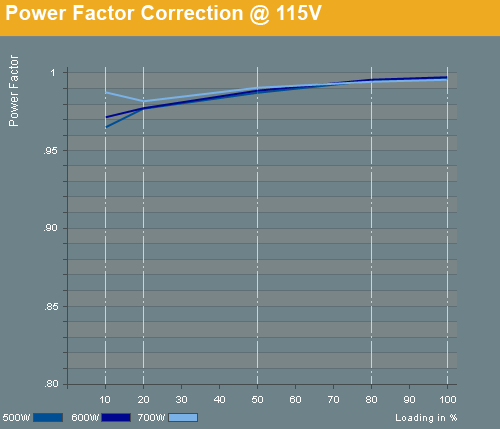
Anyone who pays for reactive power from the grid will be happy with the PFC these units achieve, as they are all very good.
Efficiency Comparison and How to Choose Your PSU
We wanted to explain to you how much power your system should actually use so you can make the best use of your new power supply. Of course you can load these power supplies up to the limit and still have around 87% efficiency - a result that many cheaper power supplies cannot reach even at their ideal load. However, these graphs show you where these power supplies reach their best efficiency.
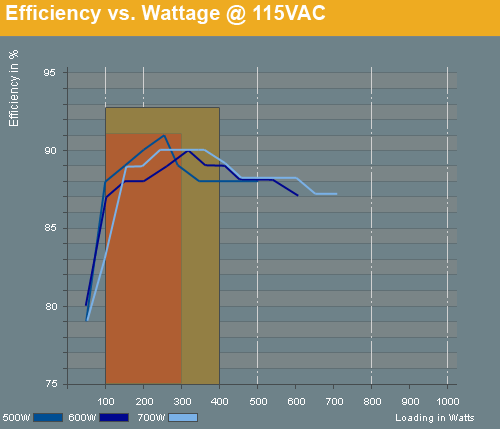
From 100 to around 400W you will get maximum efficiency if you're on a 115VAC grid. That will provide you with an 88-91-88-percent curve with the 500W unit, an 87-90-89-percent curve with the 600W unit, and an 83-90-89-percent curve with the 700W unit. If you want even better efficiency you would want to be in the darker red area of 100 to 300W output. We've combined all three PSUs on one chart, however, so you will want to consider the curves and adjust your PSU selection as appropriate, e.g. the 700W PSU performs best with a load of at least 150W.
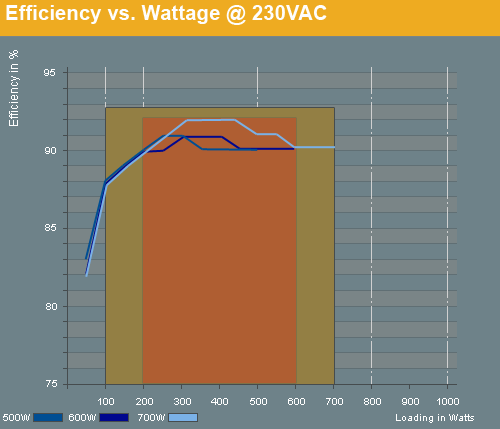
With 230VAC our recommendations look quite different. Users on a 230VAC grid can use any of these three units with any kind of load and achieve very good efficiency. Even at 5% load all of the units are still well above 80%, which is something that was difficult to reach a few years back. If you really want to squeeze the best results out of your units you will want load of at least 100W up to the maximum rated output of the PSU. That is a very large area and it shows how versatile these PSUs are. If your system uses 200W to 600W you will be able to maintain a constant efficiency of over 90%! In short, hook up just about any system to these power supplies on a 230V grid and you can be sure you'll be truly energy efficient.
Just to put things in perspective, the 80 Plus certification was introduced a few years back to put public focus on more energy efficient products, mainly power supplies. In the beginning there was only one certification, but since the initial introduction the group behind the certification has felt it necessary to introduce additional levels of efficiency. Today, we have Bronze, Silver, and Gold, with Gold being the highest level of the 80 Plus and presenting a very difficult target for the PSU manufacturers. The race to Gold has now been won, but now there's a new target in sight: Platinum. The required efficiencies for the different levels are listed below.
| 80 Plus Certification Requirements | |||
| 20% Load (Light) | 50% Load (Typical) | 100% Load (Full) | |
| 80 Plus Standard | 80% | 80% | 80% |
| 80 Plus Bronze | 82% | 85% | 82% |
| 80 Plus Silver | 85% | 88% | 85% |
| 80 Plus Gold | 87% | 90% | 87% |
| 80 Plus Platinum (230VAC only) | 90% | 94% | 91% |
Safety Functions and Maximum Wattage
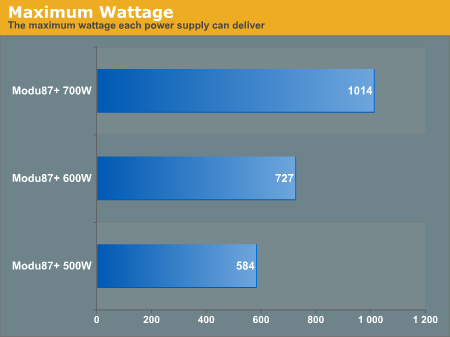
We have tested the OPP this time which shows how much power each unit is able to deliver before shutting down. The 500W unit will get you up to 584W, the 600W unit up to 727W, and the 700W unit brings a staggering 1014W before it shuts down. The result for the 700W unit is truly amazing and it means that you can compensate for almost any power fluctuation a modern high-end system could have. The 500W and 600W units also do well of course, and the above results show that all of these PSUs have very good tolerance levels - over-engineering at its best.
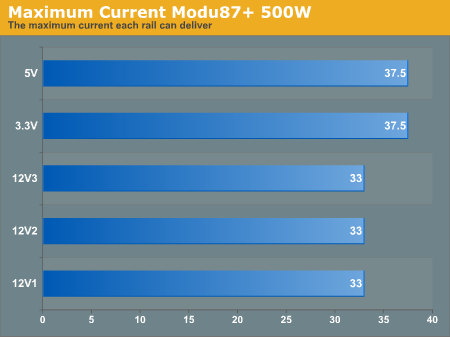
500W
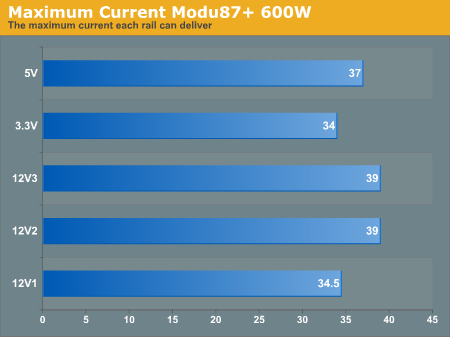
600W
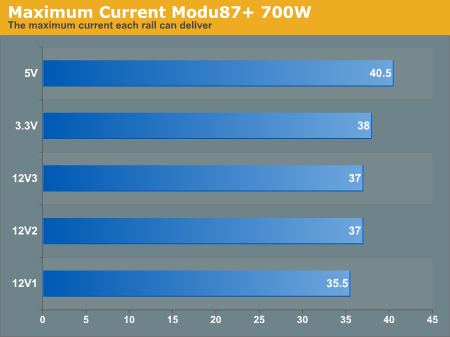
700W
In the OCP test we show how much current each of the rails can deliver before the PSU shuts down. The figures seen for each rail are totally normal since all high-end power supplies come with much higher OCPs. Why? This is an attempt to reduce the number of support problems for the manufacturer. If the OCP is too tight some people might have a unit fail on them due to a kicked in OCP. If you run a mean system or many hard drives, it is quite easy to overload one rail. To avoid problems with such systems, manufacturers label their rails at a smaller number like 20A or 25A but in fact set the OCP at 35A.
Pricing and Availability
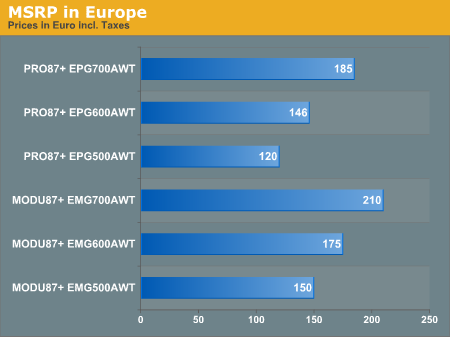
The prices in Europe are at first sight unbelievably high: 120/150€ for a 500W power supply? Yes, we are not kidding. These prices are MSRPs, so bear in mind that street prices are frequently lower, especially with better availability and more competition. We should see drops of up to 30€ within a few months since several other manufacturers will be introducing efficient 80 Plus Gold certified power supplies at CeBIT in March.
In case of direct competition, you won't find any at the moment since there are no other manufacturers with a really high efficiency 500W power supply. The next ones are certified with 80 Plus Bronze and go for around 70€. If you calculate how many years you would need to run your system to justify the 50€ to 80€ price premium, you will recognize that even your kids might have to use this power supply in their lifetime. If the prices really fall 20€ to 30€ within the near future, you might want to consider one of those units.
In the 600W region you will have the same thing. 146/175€ is simply too much and Enermax shows clearly that they are taking advantage of the market exclusivity they currently enjoy. You can get 80 Plus Bronze certified units from several other manufacturers for 90€ or less. That's half of what Enermax wants to have for their Modu87+. Seasonic's X-Series with 650W is also available for around 145€ and comes with the 80 Plus Gold certification.
The suggested price of 185/210€ for the 700W units is at least getting close to other units. Other manufacturers have similar products with 80 Plus Silver certification for around 130€ (e.g. the Cougar S700 and the Silverstone Element). If you look again at the Seasonic X-Series you can get the 750W units for 170€. These two units from Enermax will need to get down to similar price levels to compete, and if they do you definitely want to consider the new Enermax models with their very compelling features.
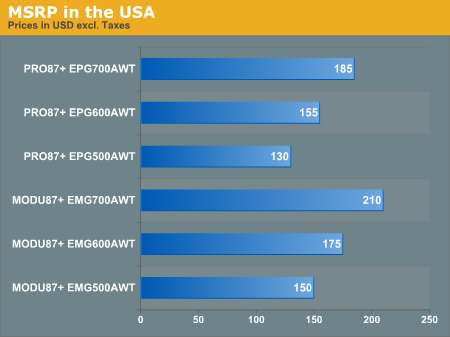
The prices in the U.S. will be similar to what we see in Europe. $130/$150 for a 500W power supply is simply too much and we hope that Enermax will bring in some really good MIRs (mail-in rebates) or other incentives to make these units affordable. Since the 500W models don't actually have a real 80 Plus Gold competitor right now, we need to go down to the Silver level where we can find PSUs like the OCZ 550W Z-Series for around $86 at Newegg (after rebate), or right now we even see a stellar price of just $50 after MIR at Zipzoomfly. You get similar performance and it will cost you $80 less, since it doesn't have any cable management. If you take another step down to 80 Plus Bronze you will have several more choices priced around $100 (sans MIR).
The MSRP of the 600W units is $155 and $175. The main competition is the Seasonic X-Series, just like in Europe, since it comes with similar technology and offerings. The 650W X-Series currently goes for $170 on Newegg, which is the same price as the Modu87+. Dropping to a Silver certification we have again an OCZ Z-Series as a direct competition; it goes for around $90 after $20 MIR, and again Zipzoomfly has a $30 MIR for a final price of $60 - it's also available at TigerDirect for $80 after rebates. With a Bronze certification you will have tons of other manufacturers and all kinds of flavors for you to choose from. There are units from Antec, Thermaltake, Silverstone, Seasonic, Corsair, OCZ, and Cooler Master to name just a few companies. Prices range from $70 to $180 so it seems Enermax wasn't completely unreasonable when they set the MSRP at $130 and $175. If we see the 600W Modu87+ at around $140 it might be worth considering.
The 700W units are priced at $155 and $210 respectively. You can already get the Seasonic 750W X-Series for around $190 and it comes with a similar overall package and technology. Alternately, you can get the Seasonic S12D 750W for around $115 if you are okay with an 80 Plus Silver certification instead of going for the Gold (and you don't care about cable management). Again, there are tons of manufacturers with lower 80 Plus Bronze certification and if you do not care about getting the latest technology you can likely find a better product at a reasonable price among those.
Conclusion
After thoroughly testing these units we can say a few things for certain. Enermax might not have reached the highest efficiency possible (that was actually HEC with their latest design), but they delivered the best overall package a power supply could possibly offer today. We had incredible efficiency, low ripple, high voltage stability, and the best acoustic noise we've heard so far. What else could we possibly ask for from a technical point of view? Let's sum up the most important parts.

Enermax introduced this new high efficiency series at Computex last year with a completely different appearance. When we saw these shipping power supplies we were surprised at the change but nothing more. To bring costs down a bit Enermax skipped the fancy paintjob and switched to a much cheaper black finish. The fan on the other hand is relatively expensive, since the gold-plating is complicated and causes a lot of rejects in production. In addition Enermax worked on the IC of the fan to make it possible to run the fans at very low RPMs. The overall appearance might not appeal to everybody, but at least these power supplies come with a fancy aesthetic that looks like it fits the name and performance.
The cables are all sufficiently long, and Enermax has been around long enough to know what's going on and what people want. We definitely don't need to worry about the cables and connectors side of things. Enermax also owns a patent for a mixed cable harness with SATA and Molex connectors, so company of course they use that style of cable harness wherever it fits. All of the standard connectors are long enough and there are plenty of PEG connectors too. Since the Modu87+ has two jacks in the back you can even fit up to four PCI-E connectors on the 500W unit if you buy an extra cable harness. The Pro87+ series has slightly shorter harnesses in some cases, but they are still long enough to fit any mid tower chassis.
The overall build quality is very good. Even though Enermax is more like a mainstream manufacturer, their products do have a modern design and aesthetic. This is particularly true when it comes to the internals. The components are well arranged and securely attached to the PCB. A quick glance may not indicate any new technologies in these power supplies, but they are there. The voltage stability is very good with drops of only a few percent. We did measure higher ripple on the lower voltage rails, but this isn't such an issue that we wouldn't recommend these power supplies; however, Enermax should work on this rather than merely providing "good enough" ripple on the 3.3V and 5V rails.
From an efficiency standpoint the numbers tell the story. The Enermax Modu87+ and Pro87+ power supplies achieve the highest efficiency we have measured thus far at AnandTech. With high efficiency come not only the benefits of saving energy, but it also helps to create a much quieter environment. Less energy transformed into heat means less heat to dissipated, so the heatsinks stay cooler and the fan can rotate more slowly. This is why Seasonic as another example is able to run their X-Series without a fan at all when they are at low loads. Enermax has a very low RPM fan that rotates at just 330 RPM most of the time and is inaudible in our testing. Even with our ear just millimeters away from the fan we were not able to hear a thing. At its highest rotation speed of 900RPM there's still nothing to hear from a 1m distance, making these PSUs perfect for a silent PC build. (Just remember to avoid noisy fans on the other components!)
We tested several safety features and found we could squeeze more than 10% extra from each PSU. Of the three models tested, the Modu87+ 700W power supply delivers the most impressive result. We managed to draw up to 45% more power than its normal rated output. All of the other safety functions such as OCPs and Short Circuit protection also performed as expected.
The one concern with these PSUs is pricing. At present, we can only say that most of the units are highly overpriced and it is clear that Enermax wants to use their current exclusive positioning for certain wattages to earn some extra revenue. Long-term we know the prices will drop a bit, but Enermax power supplies have a habit of not dropping very much compared to the competition - that's either a testament to their quality or simply successful marketing, depending on your viewpoint. Regardless of quality and marketing, a price drop is really necessary, especially in Europe where there are several other companies with similar products coming out soon. We expect to see new Gold certified products in the 450W to 1200W range from Seasonic, HEC (Cougar brand), OCZ, Corsair, Antec, and several others at CeBIT - or at latest before Computex this summer. However, if you cannot wait and have the cash to spend, we can definitely recommend these Modu87+ and Pro87+ units.
 |
For their outstanding performance, high efficiency, the for all intents and purposes silent operation, we are awarding both the Enermax Pro87+ and Modu87+ series our Gold Editors' Choice award. The price may be high, but these are currently the best power supplies in the market.




































